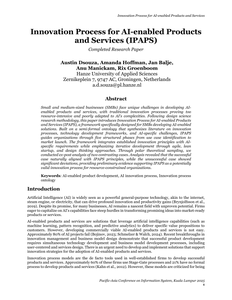Small and medium-sized businesses (SMBs) face unique challenges in developing AI-enabled products and services, with traditional innovation processes proving too resource-intensive and poorly adapted to AI's complexities. Following design science research methodology, this paper introduces Innovation Process for AI-enabled Products and Services (IPAPS), a framework specifically designed for SMBs developing AI-enabled solutions. Built on a semi-formal ontology that synthesizes literature on innovation processes, technology development frameworks, and AI-specific challenges, IPAPS guides organizations through five structured phases from use case identification to market launch. The framework integrates established innovation principles with AI-specific requirements while emphasizing iterative development through agile, lean startup, and design thinking approaches. Through polar theoretical sampling, we conducted ex-post analysis of two contrasting cases. Analysis revealed that the successful case naturally aligned with IPAPS principles, while the unsuccessful case showed significant deviations, providing preliminary evidence supporting IPAPS as a potentially valid innovation process for resource-constrained organizations.
MULTIFILE

Recently, the job market for Artificial Intelligence (AI) engineers has exploded. Since the role of AI engineer is relatively new, limited research has been done on the requirements as set by the industry. Moreover, the definition of an AI engineer is less established than for a data scientist or a software engineer. In this study we explore, based on job ads, the requirements from the job market for the position of AI engineer in The Netherlands. We retrieved job ad data between April 2018 and April 2021 from a large job ad database, Jobfeed from TextKernel. The job ads were selected with a process similar to the selection of primary studies in a literature review. We characterize the 367 resulting job ads based on meta-data such as publication date, industry/sector, educational background and job titles. To answer our research questions we have further coded 125 job ads manually. The job tasks of AI engineers are concentrated in five categories: business understanding, data engineering, modeling, software development and operations engineering. Companies ask for AI engineers with different profiles: 1) data science engineer with focus on modeling, 2) AI software engineer with focus on software development , 3) generalist AI engineer with focus on both models and software. Furthermore, we present the tools and technologies mentioned in the selected job ads, and the soft skills. Our research helps to understand the expectations companies have for professionals building AI-enabled systems. Understanding these expectations is crucial both for prospective AI engineers and educational institutions in charge of training those prospective engineers. Our research also helps to better define the profession of AI engineering. We do this by proposing an extended AI engineering life-cycle that includes a business understanding phase.
LINK
In recent years there has been much emphasis on 'research waste' caused by poor question selection, insufficient attention to previous research results, and avoidable weakness in research design, conduct and analysis. Little attention has been paid to the effect of inadequate development of interventions before proceeding to a full clinical trial. We therefore propose to enrich the development phase of the MRC Framework by adding crucial elements to improve the likelihood of success and enhance the fit with clinical practice METHODS: Based on existing intervention development guidance and synthesis, a comprehensive iterative intervention development approach is proposed. Examples from published reports are presented to illustrate the methodology that can be applied within each element to enhance the intervention design.
DOCUMENT
